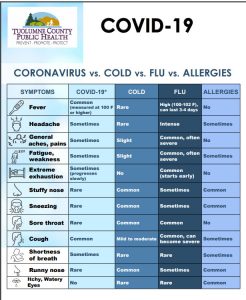Amid Coronavirus Pandemic Allergy Season Arrives In The Mother Lode
Sonora, CA — With warmer temps, and more blooming things releasing pollens, public health officials are sharing ways to distinguish between seasonal allergy symptoms and coronavirus infection.
Tuolumne County Public Health spokesperson Michelle Jachetta points out that while some symptoms of COVID-19 are shared with cold and flu infections, common allergy symptoms such as sneezing and itchy eyes are not indicators of the novel coronavirus.
Fever, general aches and pains, extreme exhaustion and sore throat (unless associated with a post-nasal drip) are not indicators of allergies.
The most common and sometimes severe symptoms of COVID-19 are a fever of 100 degrees F or more, persistent cough and shortness of breath. Two additional common symptoms are fatigue and loss of appetite. Less commonly are diarrhea, nausea, or vomiting, and some people report a lack of taste or smell. Usually symptoms appear within five days after exposure, but it can take up to 14 days.
To view an infographic from Tuolumne County Public Health, click into the image box.
While there has been some media buzz about allergy meds containing steroids possibly interfering with the body’s ability to fight off coronavirus, Jachetta says medicines with steroids in them are usually nasal sprays or inhalers, which is not the same as taking systemic steroids.
“If a medical provider has recommended allergy medications, it is recommended to follow their advice,” she recommends. Those with questions about any higher-dose steroid-containing medications they may be prescribed and concerns about any potential to interfere with their immune system should talk with their provider.

